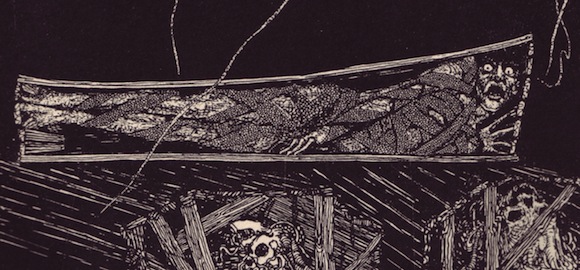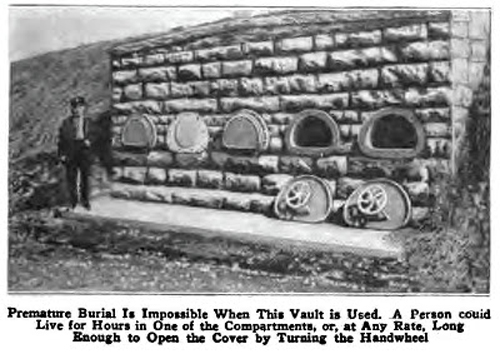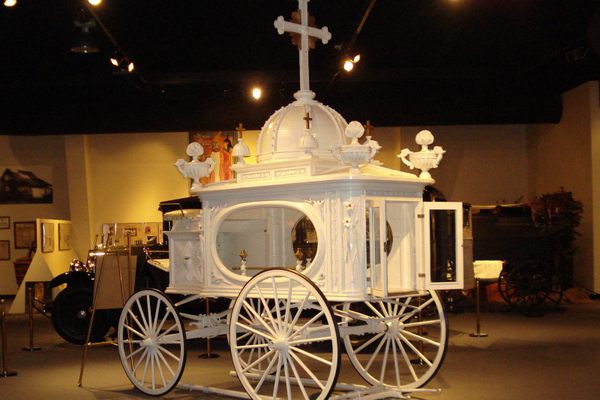Halloween Day 16: Buried Alive
31 Days of Halloween: On Atlas Obscura this month, every day is Halloween. Stop by the blog every day this month for true tales of the unquiet dead. Come for the severed heads, stay for the book bound in human skin. Every story is true, and each one is a real place you can visit. We dare you.
.jpg)
Vivi·sepulture; the action of burying, or the fact of being buried alive. Don’t worry, it probably won’t happen to you. That kind of thing could never happen nowadays…right?
Being buried alive is a fear that has been with humanity for a long, long time. As early as the Greeks one can find stories of people being prematurely pronounced dead and accidentally burned alive on their funeral pyres. At various moments throughout history, this fear, this Taphephobia, has actively gripped the Western mind. The terror wasn’t without it’s basis in reality.
One circumstance in which live burials are thought to have often taken place were during outbreaks of disease such as the black plague. Due to the rapid spread of the disease victims were buried almost immediately after death, and sometimes beforehand. These circumstances would repeat themselves again with the cholera outbreaks throughout Europe.
Throughout the enlightenment, doctors were learning more about the human body and death. As they learned to revive people who were previously considered dead (such as drowning victims via the recently invented mouth to mouth resuscitation) doctors began to question if all the people they were burying had truly been dead. With increasing reports of premature burial, by the late 1700s the fear of being buried alive had fully taken hold of the Western mind.
It was a common enough fear that in 1799 as President George Washington lay dying he told his servants ”Do not let my body be put into the vault in less than three days after I am dead. Do you understand?” to avoid such a fate.

Illustration by Harry Clark for Edgar Allan Poe’s “The Premature Burial.”)
The fear and much of the mythology surrounding being buried alive, reached its first cultural high watermark with Edgar Allan Poe’s stories “The Fall of the House of Usher” and the aptly named “The Premature Burial” which encapsulated the fear into prose. Over the next century the fear would only intensify. The Victorian Era might be called the golden age of premature burial fear. When the Duke of Wellington died in 1858, the three days Washington demanded wasn’t nearly enough to satisfy the Victorians fear of premature burial. The Duke was left above ground for a full two months, just to be sure.
So terrified were people of premature burial that numerous ways of avoiding it were devised. Methods included ways of checking for the “true death” such as a tobacco smoke enema (also believed to have powers of revival), inserting a spike beneath the nail of someones large toe, and what were known as “waiting mortuaries” where bodies were left to decompose for a few weeks before burial.
 Another route was to just make sure the victim was really, really, super dead. From the “if they weren’t dead before, they defintly are now” school of thought, some doctors would avoid live burial by stabbing the corpse through the heart, removing the heart entirely or by decapitating the corpse. A special coffins was even made so that when closed with coffin nails, it punctured tubes of poison gas, and gassed the corpse to death. (All of which was presumably done to save someone the fate of being buried alive, but feels a bit counter-productive to this humble writer.)
Another route was to just make sure the victim was really, really, super dead. From the “if they weren’t dead before, they defintly are now” school of thought, some doctors would avoid live burial by stabbing the corpse through the heart, removing the heart entirely or by decapitating the corpse. A special coffins was even made so that when closed with coffin nails, it punctured tubes of poison gas, and gassed the corpse to death. (All of which was presumably done to save someone the fate of being buried alive, but feels a bit counter-productive to this humble writer.)
In 1896, reformer William Tebb (and early anti-vaccination nut) was concerened enough about live burial that he founded the London Association for the Prevention of Premature Burial. In 1905 Tebb conducted a survey in which he claimed to find evidence of ”219 cases of near live burial, 149 actual live burials, 10 cases of live dissection and 2 cases of awakening while being embalmed.”
While to modern eyes this may seem like a strange fear from a past era, there have been a number of more modern cases. One amazing case was that of Angelo Hays, a frenchman who was buried alive in the 1930s during a coma, but rescued when he was dug up two days later becuase of an insurance investigation. He later poured his money into an elaborate escape coffin, complete with supplies and a two way radio.
Recently vivisepulture has been making headlines again. Earlier this year a South African man believed to have died of an asthma attack awoke twentyone hours later in total darkness inside a cold chamber in the morgue. Only by yelling from within was he rescued. In September of 2011, a Brazilian woman, Rosa Celestrino De Assis, was declared dead. When her daughter went to give her dead body a final hug in the morgue, she noticed the corpse was breathing. In her words “Not only did I have to go collect my mom from a cold storage drawer at the morgue, but when I got there, I find her still breathing.” The woman was rushed back to the hospital, but sadly, died two days later.
Both of these may have been cases of a medical phenomenon called the “Lazarus syndrome.” Also known as the Lazarus phenomenon, it takes place when after numerous failed attempts at resuscitation, a victims heart spontaneously begins to beat again, returning the victim to life. Though rare, there are multiple documented cases and it may be more common than reported. From a report in medical journal anesthesia-analgesia:
“Although only a handful of such cases have appeared in the literature, there has been speculation that the Lazarus phenomenon occurs more often than those few reports would suggest. Possible explanations for the reluctance to report these cases include: 1) a concern regarding medicolegal ramifications, 2) a fear of being criticized for negligence or hyperbole, 3) the lack of a satisfying physiologic explanation for the events, 4) the lack of complete documentation or monitoring of the event, and 5) the physician’s disbelief of his or her own observations.”
In the words of the doctor and author of the report
“It is a humbling reminder to find that our efforts and judgements are not necessarily the final arbiters of outcome. Perhaps it is a supreme hubris on our part to presume that we can reliably distinguish the reversible from the irreversible, or the salvageable from the nonsalvageable.”
There are a number of excellent sites that can be visited which pertain to being buried alive.
One is a beautiful grave in Recoleta Cemetery in Buenos Aires, belonging to a young girl named Rufina Cambaceres, who is said to have been buried alive. (The veracity of this particular claim is up for debate.) Another excellent site is the grave of Thomas Pursell in Wildwood Cemetery in Williamsport, Pennsylvania, (shown above in the black and white picture) who was buried with “an ax, a hammer and a piece of bread” in a ventilated, felt lined coffin that could be opened from the inside, and for a look at some safety coffin designs, try the Undertakers Museum in Vienna, Austria, the Museum of Funeral Customs in Springfield, Illinios, or the National Museum of Funeral History in Houston, Texas.
For much more on this topic read the fantastic “Buried Alive” by Jan Bondeson, the definitive guide to this fascinating subject.
DIG IN
RUFINA CAMBACERES, Buenos Aires, Argentina
THOMAS PURSELL, Wildwood Cemetery, Williamsport, Pennsylvania
UNDERTAKERS MUSEUM, Vienna, Austria
MUSEUM OF FUNERAL CUSTOMS, Springfield, Illinois
NATIONAL MUSEUM OF FUNERAL HISTORY, Houston, Texas








Follow us on Twitter to get the latest on the world's hidden wonders.
Like us on Facebook to get the latest on the world's hidden wonders.
Follow us on Twitter Like us on Facebook